
Earth: the Blue planet
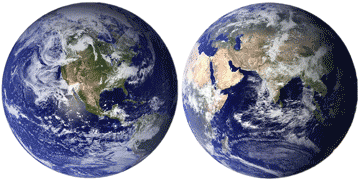
Water on the Earth's surface has allowed life to develop.
![]() Hard water, descaling, and desalination
Hard water, descaling, and desalination
![]() Water in the mantle
Water in the mantle
![]() Water and global warming
Water and global warming
![]() Water cycle
Water cycle
![]() Water availability
Water availability
![]() Water use
Water use
When the well’s dry, we know the worth of water
Benjamin Franklin
A glacier-eroded U-shaped valley
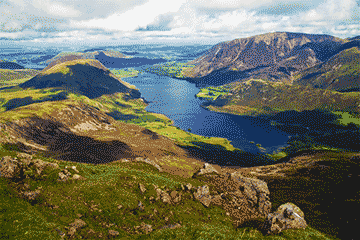
Water and ice have been central in shaping the surface of the Earth due to erosion from rivers and glaciers (see left for the glacier-eroded U-shaped valleys in the Lake District of the UK). As well as adding to the beauty of the countryside, this increases the area of fertile areas for agriculture.
Water dissolves well in the mantle rocks. It plays a crucial role in the mantle by reducing friction between moving rock and reducing the melting point of such rock, lowering its density, and reducing its viscosity, encouraging the tectonic plates' movement , seismic activity (earthquakes), and volcanic activity. For example, at 1000 MPa and 1200 °C, the solubility of H2O in the basaltic melt is 206 ± 9 g ˣ kg−1 [3097]. The presence of ice VII in diamonds points toward fluid-rich locations around the 660-kilometer upper boundary of the lower mantle (≈ 24 GPa) [3251].
Earth's tectonic plates
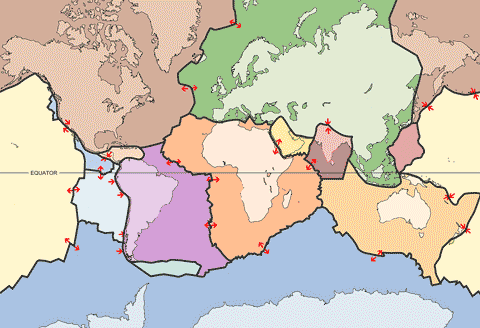
The outer shell of the Earth (lithosphere) consists of separate and distinct extensive rock layers (tectonic plates; see left), which float on the solid but fluid-like viscoelastic layer beneath (asthenosphere). The relative fluidity of the asthenosphere allows the tectonic plates to move (see red arrows left). The movement is caused by the upswelling of the asthenosphere, as particularly noticed in the mid-Atlantic ridge, a deep rift valley that spreads by about 2.5 cm per year. This motion is facilitated by water in and between the layers that reduce the friction. The water is drawn deep into the Earth (subduction) as one plate rides on top of another, taking many millennia to reappear in volcanic gases.
[Back to Top ![]() ]
]
Projected global warming 1980-2050
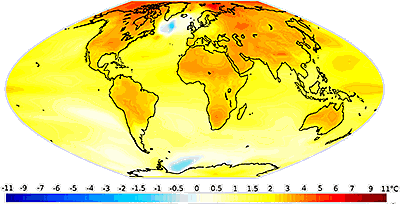
There has been much debate concerning global warmingd over the last 50 years. Sometimes the science has been drowned out by the presence of many lay commentators, chosen to 'balance' the arguments rather than for their scientific expertise. Because of this, there is a danger of opinion rather than science unbalancing the debate. Modeling climate change is inexact, with many mostly understood, little understood, and unknown variables. There are complex multi-factorial inter-relationships that cause the predictions to be imprecise with wide uncertainty.
The Earth's surface warms mainly due to the Sun's shorter wavelengths of visible radiation (see spectrum). This radiation is absorbed, and some of the energy is radiated back outwards towards space as longer-wavelength infrared radiation. The atmosphere is mainly transparent to visible radiation but contains several molecular gases (H2O and CO2) that absorb infrared radiation.e
During Earth's existence, it has warmed and cooled many times due to natural events such as continental drift with the land occupation at the poles preventing warm water from the tropics melting and removing frozen water from these coldest regions of the world so allowing that to build up to cause glaciations [3692]. Some of these temperature shifts have been quite extreme, such as the Snowball Earth (650 Mya) when the Earth was almost entirely frozen, through many ice age events to the last ice age (from 2.6 Mya to about 0.024 Mya). These have involved mass extinctions and the evolution of new species. Ten of the warmest years on record (since 1880) have come in the last twenty years, with five of the warmest in the last seven years (up to 2017). Cooling towards ice ages is slow as the ice builds up only slowly, whereas warming can be much faster. The range over the last 800,000 years has been about 12 °C. The warming periods follow from increasing periods increasing CO2, giving a clear connection between these phenomena [3126].
Atmospheric CO2 varies in the seasons (high in Winter, low in Summer (due to photosynthesis), and between high in the northern hemisphere and low in the southern hemisphere (due to human activity and the size of the respective landmasses). There has been concern over apparent rapid warming over the last century caused by man's industrial activity in burning fossil fuels (see the rise in atmospheric CO2 above). Fossil fuels are known to be a cause due to their higher isotopic 12C content than found in other CO2 sources. From NOAA, dire predictions of a dangerously warm Earth have been made for future decades. Other reports limit the warming to 1.5 °C from the mid-19th century to post 2015 warming, so long as present measures and pledges are honored [3061a]. It is important to note that global warming was preceded by increasing atmospheric CO2 at the end of the last Ice Age [3126]. The warming caused by this increase in CO2 has delayed the next ice age by about 100,000 years.
Global warming 1880-2014; mouse over for earlier years
![Global (land and ocean) surface temperatures, from [3061b]; mouse over for earlier data, from [3061d] Global (land and ocean) surface temperatures, from [3061b]; mouse over for earlier data, from [3061d]](images/gwarm.gif)
Additionally, reports of a recent “slowdown” in the increase of global surface temperature (see right for the last 135 yr, and mouse over for the last 1500 yr) have been challenged [3061b], leaving the field somewhat confused. The temperature increase is 0.85 °C since 1880, with about 20 cm rise in sea level and a 40% decline in sea ice.
A poorly understood component of global warming is the terrestrial carbon cycle [3061f]. This might accelerate slow climate change in the future due to human-driven land-use changes in Earth's forests [3061c]. Aerosols, f produced with the warming CO2 and that have an overall cooling effect by reflecting incoming sunlight, have helped to reduce, by over a third, the warming effect from the CO2 emissions. As CO2 emissions are reduced, so will the cooling effect of air pollution [3254]. Trees are essential in the control of CO2 and O2 in the atmosphere. For each ton of dry wood, 1.851 tons of CO2 is removed from the atmosphere, being replaced by 1.393 tons of oxygen gas (973 m3 of pure O2) and 0.541 tons of water [3842]. However, these amounts are reversed if the wood is burnt.
The maximum water in the air
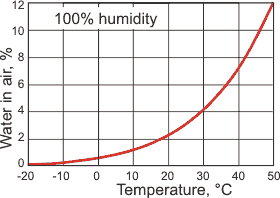
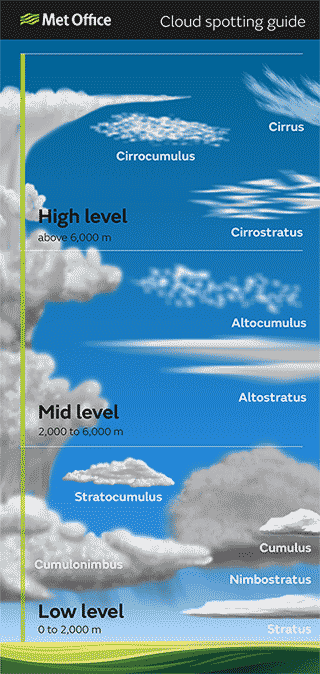 Water is the most important absorber of the sunlight in the atmosphere (see elsewhere). In particular, it is a strong absorber of the infrared radiation from the Sun-warmed Earth before it radiates back into space. As warm air holds much more water than cold air (see left), an increase in the atmosphere's temperature causes an increase in Earth's blanket of water vapor and a further warming effect. The 13 trillion tons of water in the atmosphere (≈ 0.33%
by weight; compare to CO2 ≈ 0.04% by weight) is responsible for about 70% of all atmospheric
absorption of radiation. This is mainly in the infrared region, where
water shows its strongest absorption. It contributes 50 % to 60 %
to the Greenhouse effect; more than twice that due to animal and anthropogenically associated carbon dioxide, ensuring a warm habitable planet. Water operates a negative feedback effect, due to the cloud formation that reflects the sunlight away (see Quicktime movie) and the oceanic export of latent heat
to attenuate global warming. Also, atmospheric water reduces the outgoing longwave radiation (OLR) from hotter surface temperatures such that the OLR is an essentially linear function of surface temperature over a wide range of temperatures, rather than obeying the Stefan-Boltzmann law (black-body radiation proportional to the fourth power of the surface temperature) [3441]. Rising atmospheric CO2 is accompanied by an increasing atmospheric humidity [3061e] due to (1) a positive feedback effect, (2) warmer air absorbing more water, and (c) man's activities. c Note that, without this Greenhouse effect, the average temperature on Earth would be well below the freezing point, and the Earth would be in a permanent ice age. Although water vapor absorbs more radiated heat than CO2, the amount of H2O in the atmosphere is stabilized by its loss by increased rainfall. No such mechanism exists for CO2 which may build up in the atmosphere and have a more significant influence on global warming.
Water is the most important absorber of the sunlight in the atmosphere (see elsewhere). In particular, it is a strong absorber of the infrared radiation from the Sun-warmed Earth before it radiates back into space. As warm air holds much more water than cold air (see left), an increase in the atmosphere's temperature causes an increase in Earth's blanket of water vapor and a further warming effect. The 13 trillion tons of water in the atmosphere (≈ 0.33%
by weight; compare to CO2 ≈ 0.04% by weight) is responsible for about 70% of all atmospheric
absorption of radiation. This is mainly in the infrared region, where
water shows its strongest absorption. It contributes 50 % to 60 %
to the Greenhouse effect; more than twice that due to animal and anthropogenically associated carbon dioxide, ensuring a warm habitable planet. Water operates a negative feedback effect, due to the cloud formation that reflects the sunlight away (see Quicktime movie) and the oceanic export of latent heat
to attenuate global warming. Also, atmospheric water reduces the outgoing longwave radiation (OLR) from hotter surface temperatures such that the OLR is an essentially linear function of surface temperature over a wide range of temperatures, rather than obeying the Stefan-Boltzmann law (black-body radiation proportional to the fourth power of the surface temperature) [3441]. Rising atmospheric CO2 is accompanied by an increasing atmospheric humidity [3061e] due to (1) a positive feedback effect, (2) warmer air absorbing more water, and (c) man's activities. c Note that, without this Greenhouse effect, the average temperature on Earth would be well below the freezing point, and the Earth would be in a permanent ice age. Although water vapor absorbs more radiated heat than CO2, the amount of H2O in the atmosphere is stabilized by its loss by increased rainfall. No such mechanism exists for CO2 which may build up in the atmosphere and have a more significant influence on global warming.
See [3919] for a complete energy balance for the Earth. Clouds reflect sunlight away from the Earth, trapping the heat that radiates from the Earth's surface, and re-emitting absorbed heat, resulting in a complex and somewhat uncertain relationship between global temperature and cloud cover. The water content of the atmosphere varies about 100-fold between the hot and humid tropics and the cold and dry polar ice deserts (see above right and Quicktime movie). Clouds typically contain liquid water aerosol droplets of 10 µm - 15 µm in diameter but ranging between 1 µm - 100 µm in diameter, with them well-spaced (~1 mm apart) at ~108 m-3, and typically about 100x smaller than raindrops. They have a complex and controversial relationship in global warming as increased cloud cover insulates the planet, contributing to global warming by preventing heat loss. It also reflects sunlight into space, so cooling the planet, with relative effects dependent upon the type and height of the clouds. If increasing water vapor leads to warmer temperatures, more water vapor will be incorporated into the atmosphere and warming, and water absorption will increase in a spiraling cycle. By contrast, if increased cloud cover leads to cooling, then the system will be stabilized. Changes in other gases, such as CO2 will feed into these effects [2222]. On balance, it appears that increased atmospheric CO2, is feeding into a global warming spike in an otherwise cooling Earth.
Used by permission of The Center for Sustainability and the Global Environment,
Nelson Institute for Environmental Studies, University of Wisconsin-Madison
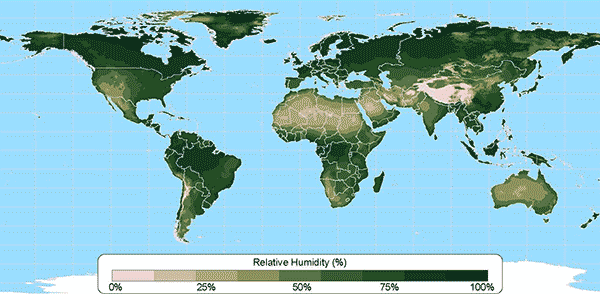
Cloud cover and atmospheric vapor content, from NASA satellite observations
Cloud cover September 2014 Water vapor without clouds
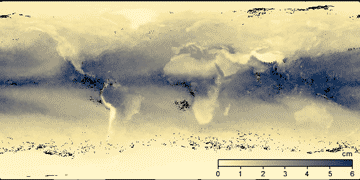

The current knowledge concerning ice formation within clouds has been outlined [2477]. Cloud condensation nuclei (aerosol particles, cloud seeds; such as sea salt, carbon black, and 'dust') are particles with a dry diameter larger than 70 nm, forming cloud droplets at 0.22 % supersaturation. They are seen to have increased substantially during the industrial age [2424]. Over half of the atmosphere's cloud condensation nuclei are formed in situ from highly oxidized molecules, such as sulfuric acid, binding ammonia [2584].
Cloud condensation nuclei changes over the industrial age, from [2424]
![Cloud condensation nuclei changes over the industrial age, from [2424] Cloud condensation nuclei changes over the industrial age, from [2424]](images/cloud-droplet.gif)
Polar ice affects our climate as its white surface has a high albedo (reflectance) of up to about twelve times that of the open ocean. Any reductions in sea ice or the darkening of the ice caps due to lack of fresh snow exerts positive feedbacks in global warming.
The pattern of warming is very different at the North and South Poles (see above), with the Arctic losing ice, on average if not consistently, and the Antarctic gaining ice. The rate of warming in the Arctic is near twice the global average, but it is used by the media as though it is typical of global warming. It has been proposed that this difference between the poles is due to the ocean flow [3024]. Warmer water, caused by global warming, flows to the Arctic and causes a reduction in surface sea ice. However, the northward flow of this warmer water is balanced by the deep Northern Ocean's water returning south to well up in the Southern Ocean. Here, before being warmed at the surface, it is drawn northwards to be replaced by the deep, cold water. Thus, global warming causes the oceans to increase the warming of the Arctic, whereas they reduce noticeable warming around Antarctica. It is no surprise that the Southern Ocean has shown little warming over recent decades, although warming may emerge in later decades as the deep Northern oceans are warmed. Note the patch of cold water in the North Atlantic (see above) due to buoyant salt-free water from the melting Greenland ice cap.
Sea level rise (mouse over for levels since the last ice age [3124])
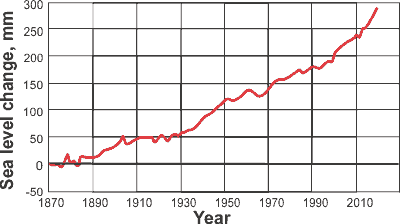
The mean sea level has risen ≈ 120 m since the last ice age (≈ 20,000 years ago, a melt of ≈ 5 ˣ107 km3 of land-based ice) and, without man's interference, would have likely continued to rise slowly (≈ 0.4 mm ˣ yr−1) towards that of the last interglacial period (+6 - +9 m, 130,000 to 115,000 years ago). Recently, the masses of both the Greenland ice sheet and the Antarctic ice sheet have rapidly and increasingly declined due to surface melting and iceberg calving. Between 2002 and 2016, Greenland and Antarctica shed approximately 305 km3 and 136 km3 of ice per year, respectively. This has caused the global sea-level to rise by 0.8 mm ˣ yr−1 and 0.35 mm ˣ yr−1, respectively [NASA]. These contribute to the estimated current long-term sea level rise of 3.4 mm ˣ yr−1 from satellite data [NASA], with the 2010-2020 rate of 4.8 mm ˣ yr−1 [4163]. Much of the difference is due to other melting land ice plus a smaller contribution from the expansion of water due to temperature rise. The high specific heat of water slows both the current global warming process and any future if now thought improbable, cooling recovery after greenhouse gas emissions are curtailed. It is expected that the oceans may rise by at least 28 centimeters by 2100. It should be noted that current land level rises and falls may be equal to the sea-level changes in some places; for example, Scotland has a rising landmass of about 3 mm ˣ yr−1 due to rebound from the loss of ice sheets present during the last ice age.
The decline in the dissolved oxygen concentration in the oceans and coastal waters is partly due to global warming and other human activities modifying nutrients and aquatic species [3146].
A further point of dispute concerns the shape of the Earth. Higher gravity at the poles attracts the water from tropical areas with lower gravity such that any rise in the oceans would not necessarily be evenly distributed [3212]. There would also be polar uplift due to the loss of land-based ice.
Massive iceberg on the horizon in the Southern Ocean

The rates of evaporation of both water droplets and ice crystals are limited by the diffusive transport of the vapor. Therefore, the evaporation from ice and snow (sublimation) is similar to that of water drops [3446]. The rate of ice crystal sublimation [4111] is particularly important as it has a major impact on global climate since surface ice and snow determine Earth’s albedo.
[Back to Top ![]() ]
]
The Water Cycle,
with the background from the Amazon rainforest
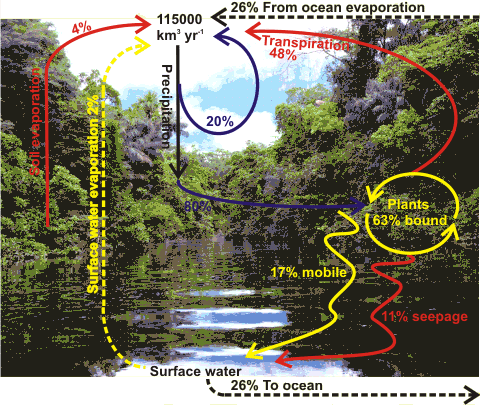
The high specific heat of water allows Earth's climate to be even-tempered, with an annual turnover of huge amounts of water in the water cycle (see right). An outline of the water cycle on Earth is thought to have been first recognized and observed by Leonardo da Vinci (1452-1519) [2494]. Now, it can be partially represented by the diagram right [2357]. Water has a lifetime in the atmosphere of about a week, on average, before precipitation. 20% of this precipitation over land evaporates before it reaches the ground. Of the remaining 80%, about a fifth is run-off into the river system. Most of the remainder goes into the soil and vegetation, and 3/4 of this is returned to the atmosphere by transpiration with the remainder seeping to the river system or evaporating from the soil. The daily flux of water through the atmosphere is about 1260 km3. Transpiration is the primary route for returning water to the atmosphere over land, with plants releasing about 300 molecules for every CO2 molecule captured during photosynthesis [2357].
Some seawater gets subducted, between tectonic plates, hundreds of kilometers down into the mantle, taking with it small amounts of organic carbon and taking many millennia to reappear. Reactions occur under these extreme conditions (900 °C, 5.0 GPa), and materials like oil and diamonds may be formed [2453].
[Back to Top ![]() ]
]
Nordaustlandet ice cap
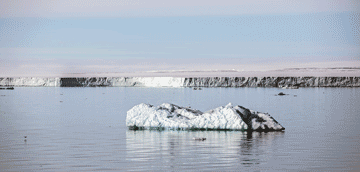
Only 2.5% of the water on Earth is freshwater (< ≈ 0.5 g ˣ kg−1 salt in widely varying proportions; freshwater is not necessarily potable water). Most of that fresh water is frozen in the ice caps of Antarctica, Greenland, and Svalbard. Most of the remainder is inaccessible. Less than 0.9 % of the world's freshwater is in lakes, rivers, reservoirs, and accessible underground sources (≈ 9.3 ˣ 104 km3) that can be used for drinking, cooking, hygiene, industry, and agriculture. By 2030, the world’s population will consume over 6% of this water per year, with billions living under severe water stress. Presently, over half the world's population has access to piped water on premises, but about 10% still have to use surface water and other poor, potentially unsafe, sources. Although small as a percentage, this 10% represents over 700,000,000 people. The map below shows the scarcity of blue water (fresh surface water and groundwater) throughout the world [2603]. 2021, in particular, has seen droughts over large areas of the Earth worsening with climate change [4307].
Addressing this is not cheap, with achieving universal safely managed water and sanitation services by 2030 is estimated to require 114 billion US$ per year [3108]. Early settlements were near rivers and lakes. However, clean water is increasingly being provided through energy-requiring water collection, desalination, and transport. Droughts drive mass migrations, famine, and conflicts.
Drought areas of the Earth, from [2603]
![The number of months per year in which blue water need was not met; 1996-2005 from [2603] The number of months per year in which blue water need was not met; 1996-2005 from [2603]](images/scarce.gif)
There have been significant recent improvements in India and China. Even so, poor drinking water is the biggest threat to India’s public health because 86% of India’s diseases are directly related to its quality [3353]. Much of the rural areas of Africa are poorly served and not improving year on year [2174]. Water scarcity is linked to famines and conflicts. Few people these days consider freshwater to be abundant, and they believe that there are likely to be shortages in the future. We need adequate, safe, and affordable water to lead healthy lives, industrialize, and build secure livelihoods [2176]. It will be challenging to achieve this end for the poorest in society.
[Back to Top ![]() ]
]
Water is required for drinking (≈ 3 L ˣ day−1 ˣ person−1), cooking (≈ 10 L ˣ day−1 ˣ person−1), sanitation (≈ 20 L ˣ day−1 ˣ person−1), and washing (≈ 15 L ˣ day−1 ˣ person−1). In western cities, we are wasteful in our water usage, using 6-10 times these necessary amounts, whereas in rural third-world countries, they get by on 10 L or less per day. The global domestic average is 184 L ˣ day−1 ˣ person−1 (455 km3 ˣ year−1), and the global industry average is 300 L ˣ day−1 ˣ person−1 (739 km3 ˣ year−1 ) [2570]. Only about 1.7 % of the domestic water waste is reused, mainly for irrigation, with the rest being wasted through evapotranspiration or the sewerage system. Approaches to urban water management have been reviewed [2570]. The water we use domestically forms a very small apercentage of the freshwater required for modern life. As examples [2175], a liter of beer requires 300 liters (including growing the barley; a liter of milk requires 1000 liters (including farming the cows); a cup of tea requires 120 liters, a kg of potatoes requires 950 liters; a pair of leather shoes requires about 10,000 liters; a kg of beef requires up to 70,000 liters, and even a 2-gram microchip requires 32 liters. As water supplies become more expensive and subject to greater demand, ways are continually being sought to reduce these industrial water usage figures. The value of water used in the irrigation of different crops has been evaluated [4069].
Water plays a central role in the world's religions as it is necessary for life and is a cleanser of body and spirit.
[Back to Top ![]() ]
]
c Using oil or gas as a fuel produces approximately equal molar amounts of CO2 and H2O. [Back]
d Global temperatures are gathered and combined using several sources. Land temperatures are determined in the air above ground and not the ground itself, typically from automated weather stations. Sea surface measurements are from ships and static or drifting buoys. Weather satellite observations measure atmospheric temperatures using microwaves. The World Meteorological Organization recommends defining the temperature of a location as the average of the maximum and minimum temperatures recorded during 24 hours. Historical data obtained by different methods are adjusted by various factors and use the baseline set by these modern observations. These adjustments reduce the trends but do not change the conclusion that global warming is real. [Back]
e The stretch vibration of O2 and N2 involves no change in dipole moment (always zero), so there is no infrared absorption. The asymmetric stretch of CO2 involves continually changing dipole moment such that it absorbs radiation of the same frequency as the dipole moment changes.
Asymmetric stretching causes dipole movement

[Back]
f A. Voiland, Aerosols: Tiny particles, big impact, https://earthobservatory.nasa.gov/features/Aerosols, accessed 5 Sept 2019. [Back]
Home | Site Index | Water and life | Water and astrobiology| Hydration, water and health | LSBU | Top
This page was established in 2014 and last updated by Martin Chaplin on 22 March, 2022